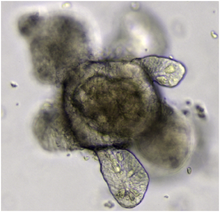Recombinant Human and Murine HGF: Scientific background and Collaboration Opportunity
Scientific background
Hepatocyte Growth Factor (HGF), also known as Scatter Factor (SF) and Hepapoietin A (HPTA) is a multifunctional growth factor found throughout the body. C-Met is the receptor and pathway associated with HGF. As like other growth factors, HGF is capable of regulating cell growth, cell motility, and cell death for a variety of different cell types found in many different tissues and organs though out the body. As such, HGF possesses the ability to regenerate many different tissues. However, its ability to enable cell growth and migration also gives it a central role in angiogenesis and tumorogenesis in many diseases, including quite a few cancers. Therefore, there has been research on both HGF and anti-HGF.
Below are just some of the therapeutic potential applications of HGF.
Therapeutic Potential: Regeneration
All growth factors have some regenerative potential and play key roles in both the development of tissues as well as natural upkeep and repair. HGF has also shown that it is capable of regeneration and repair in unusual circumstances. Moreover, the addition of exogenous HGF has had positive, regenerative effects in numerous organs in the body, including the brain, heart, and liver. The large regenerative potential of HGF provides many opportunities to test when the addition of HGF can aid in healing, repairing, and regenerating critical organs and systems in the body. Some examples of current findings include:
Brain & Nervous System:
A research group in Japan has shown that the addition of HGF after tMCAO (transient middle cerebral artery occlusion) resulted in a significantly reduced infarct size and a decrease of TUNEL-positive cells. HGF also increased the number of BrdU-positve cells into mature neurons. Furthermore, HGF enhanced angiogenesis and synaptogenesis while decreasing the glial scar formation and scar thickness.1
Another research group has demonstrated that the addition of HGF into MSCs provides better treatment than MSCs only. In both cases the MSCs are transplanted into rabbits that then undergo spinal cord ischemia. While both groups increased the number of intact motor neurons and improved the lumbar spinal cord, the HGF modified MSCs were significantly better than the normal MSCs.2
Heart & Circulatory System:
One research group is making great strides in using HGF to differentiate MSC into hepatocytes. The HGF is released over time from a chitosan nanoparticle, which provides for greater control and a more constant presence of HGF. The differentiation of MSC into hepatocytes can be used to regenerate damaged hearts.3
Another method to regenerate the heart has been found by a separate research group in Israel. This group is using a biomaterial that is releasing first IGF-I and then HGF onto damaged tissue following acute MI (myocardial infarction). The combination of the two growth factors resulted in increased angiogenesis, more mature blood vessel formation at the infarct, and prevented cell apoptosis.4
A separate research group examined the potential of HGF to induce bone marrow stromal stem cells (BMSC) into cardiomyocyte-like cells. HGF played a pivotal role in the development of the BMSC into the cardiomyocyte-like cells. These cells were able to provide some therapy of ischemic heart disease.5
Muscular System:
Multiple research groups have identified HGF and other growth factors present during muscle regeneration. One group in particular examined the muscles in polymyositis / dermatomyositis (PM/DM) patients. Their research showed that addition of exogenous HGF in cultured myoblasts had many positive effects, such as enhancing the gene expression of muscle regulatory factors. These results point towards the potential for HGF to be given to DM/PM patients to contribute to muscle regeneration.6
Liver & Digestive System:
Research conducted at the National Institutes of Health has shown that HGF / c-Met signaling is critical for persistent Erk ½ activation during liver regeneration.7 Other research has examined the regeneration of the liver with the delivery of bone marrow mononuclear cells (BMMC) and HGF after acute liver failure. While BMMC without HGF showed some promising results, the combination of HGF with BMMC improved both the functional and histological liver recovery.8
Therapeutic Potential: Synergy
As with the previous examples, there has been much research that looks at the therapeutic potential of HGF acting in combination with other growth factors, stem cells, or other cytokines.
One such example is the combination of HGF with VEGF (vascular endothelial growth factor). One research group examined the benefits of adding both HGF and VEGF to transplanted islets. The islets transplanted with both growth factors were capable to restore normoglycemia while those transplanted without the growth factors failed to reverse diabetes. Moreover, only the group that had both growth factors, as opposed to the group with neither and both groups with only one growth factor, revealed significantly more blood vessels to the islets.9 Other research is looking at the potential synergy of HGF with either VEGF or KGF for lung repair. While HGF has no specific task in the lungs, HGF has the potential to improve the ability of the other growth factors to treat acute lung injury.10
Other research has focused on the use of HGF in combination with stem cells. One such experiment has examined the benefit of adding HGF to mesenchymal stem cells (MSC) to aid in the recovery from intracerebral hemorrhage (ICH). There was a significant improvement of motor function recovery and overall better neurological recovery in the MSC with HGF group as compared to the other groups.11
Therapeutic Potential: Biomarker
Other than having much potential in regeneration both alone and in combination with other growth factors, HGF can be very useful as a biomarker. For example, HGF serum levels are elevated at the early stages of dengue virus infection and could possibly be used to predict whether the infection progresses to DHF.12
Another example is the difference in HGF expression in the cerebrospinal fluid (CSF) between patients with Parkinson’s disease and normal controls. While the two groups had the same level of HGF in serum, the CSF HGF expression was significantly higher in patients with Parkinson’s disease as compared to the controls.13
HGF can also be used as a biomarker for patients with chronic hepatitis C (CHC).
The serum concentrations of HGF were much higher in patients with CHC as compared to healthy controls.
Moreover, the HGF concentration correlated with the fibrosis score of the patients.14
HGF levels are also useful as biomarkers for multiple types of cancer. In periampullary cancer (PAC), there is a significant difference in plasma HGF levels of those suffering from PAC as compared to other, benign pancreatic diseases and normal controls.15
Therapeutic Potential: Survival
HGF has the potential to ensure cell survival by a few different mechanisms. One instance is how the HGF / c-Met pathway when activated can ensure the survival of mature B cells with the CD74 induced survival pathway. The Blocking of the c-Met pathway results in induction of mature B cell death.16
Another pathway that HGF uses to block cell apoptosis is the PI3K/AKT pathway. While cigarette smoke extract can induce apoptosis, the addition of HGF significantly blocked the cell apoptosis but that effect could be prevented with PI3K inhibitors.17 Further research on the cell survival capabilities of HGF, this time with cells surviving exposure to hydrogen peroxide, were also dependent on the PI3K/AKT pathway.18
Therapeutic Potential: Other
In the kidneys, HGF has the ability to promote myofibroblast apoptosis, which can limit the progression of chronic kidney disease (CKD).19
On the other hand, in the liver HGF can be used to limit the inflammatory response from total parenteral nutrition (TPN) induced liver injury. HGF plays an important role in limiting apoptotic activity and might be able to limit the liver injury.20
In the initial stages of development, HGF enables the progression of follicular development 21 while other researchers have demonstrated that HGF is an anti-adhesion agent.22
There has also been research showing that HGF levels correlate with depression. The severity of the depression correlates with HGF serum levels.23
Collaboration Opportunity:
SBH Sciences recombinant human HGF is produce by Hi5 insect cells and it is glycosylated. It is sold on the R&D market for more than 10 years. The protein is an 80 kDa disulfide-linked heterodimeric protein consisting of the alpha chain (463 amino acids) and the beta chain (234 amino acids). The product is fully active as can be seen by complete dissociation of the two chains under reduce conditions. The In-Vitro activity of the recombinant protein is measured based on cell growth stimulation of 4MBR-5 cell line. The ED50 for this effect is typically 20-40 ng/ml.
SBH Sciences recombinant mouse HGF is also produced by Hi5 insect cells and it is glycosylated. The protein is an 80 kDa disulfide-linked heterodimeric protein consisting of the alpha chain (463 amino acids) and the beta chain (233 amino acids). The product is fully active as can be seen by complete dissociation of the two chains under reduce conditions. The In-Vitro activity of the recombinant protein is measured based on cell growth stimulation of IMCD-3 mouse epithelial cells. The ED50 for this effect is typically 10-20 ng/ml. The mouse HGF allows more accurate animal model studies.
SBH Sciences is looking for partners to investigate the potential of using recombinant HGF as therapeutic agent, as well as diagnostic tool. Moreover, availability of our extensive bioassay support and the highly pure protein will also support project that aim to produce anti-HGF (e.g., small drug-like substance or monoclonal antibodies).
We are open for suggestions and would be pleased to hear from you.
References:
1. Shang J et al, Journal Of Neuroscience Research, 89(1) 86-95, Jan 2011.
2. Shi E et al, Anesthesiology, 113(5) 1109-17, Nov 2010.
3. Pulavendran S et al, Institution Of Engineering And Technology, 4(3) 51-60, Sep 2010.
4. Ruvinov E et al, Biomaterials, 32(2) 565-78, Jan 2011.
5. Wen Q et al, Journal Of Southern Medical University, 30(7) 1537-40, Jul 2010.
6. Sugiura T et al, Clinical Immunology, 136(3) 387-99, Sep 2010.
7. Factor VM et al, PLoS One, 5(9) e12739, Sep 2010.
8. Jin SZ et al, Journal Of Hepato-Biliary-Pancreatic Sciences, Nov 2010.
9. Golocheikine A et al, Transplantation, 90(7) 725-31, Oct 2010.
10. Lindsay CD, Human & Experimental Toxicology, Jul 2010.
11. Liu AM et al, Neurosurgery, 67(2) 357-65, Aug 2010.
12. Voraphani N et al, Annals Of Tropical Pediatrics, 30(3) 213-8, 2010.
13. Salehi Z et al, Journal Of Clinical Neuroscience, 17(12) 1553-6, Dec 2010.
14. Marin-Serrano E et al, Revista Espanola De Enfermedades Digestivas, 102(6) 365-71, Jun 2010.
15. Barakat O et al, Journal Of Surgical Oncology, 102(7) 816-20, Dec 2010.
16. Gordin M et al, Journal Of Immunology, 185(4) 2020-31, Aug 2010.
17. Togo S et al, Experimental Cell Research, 316(20) 3501-11, Dec 2010.
18. Hu ZX et al, European Journal Of Pharmacology, 645(1-3) 23-31, Oct 2010.
19. Iekushi K et al, Journal Of Hypertension, 28(12) 2454-61, Dec 2010.
20. Katz MS et al, The Journal Of Surgical Research, 163(2) 294-8, Oct 2010.
21. Guglielmo MC et al, Journal Of Cellular Physiology, 226(2) 520-9, Feb 2011.
22. Jiang D et al, Medical Science Monitor, 16(8) BR250-4, Aug 2010.
23. Russo AJ, Biomarkers Insights, 3(5) 63-7, Aug 2010.




SHARE